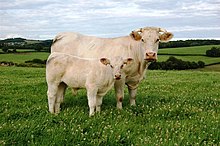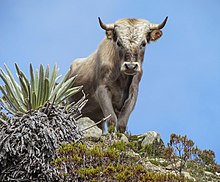Charolais cattle
This article needs additional citations for verification. (September 2014) |
show This article may be expanded with text translated from the corresponding article in French. (May 2015) Click [show] for important translation instructions. |
 Cow and calf | |
| Conservation status | FAO (2007): not at risk[1]:144 |
|---|---|
| Other names | French: Charolaise |
| Country of origin | France |
| Distribution | world-wide |
| Use | beef |
| Traits | |
| Weight | |
| Height |
|
| Coat | white [2] |
| Horn status | horned in both sexes[3] |
| |


The Charolais (French: [ʃaʁɔlɛ]) or Charolaise ([ʃaʁɔlɛz]) is a French breed of taurine beef cattle. It originates in, and is named for, the Charolais area surrounding Charolles,[4] in the département of Saône-et-Loire, in the Bourgogne-Franche-Comté region of eastern France. Charolais are raised for meat; they may be crossed with other breeds, including Angus and Hereford cattle.
History[]
The Charolais is the second-most numerous cattle breed in France after the Holstein and is the most common beef breed in that country, ahead of the Limousin. At the end of 2014, France had 4.22 million head of Charolais, including 1.56 million cows, down 0.6% from a year earlier.[5] The Charolais is a world breed: it is reported to DAD-IS by 68 countries, of which 37 report population data. The world population is estimated at about 730,000. The largest populations are reported from the Czech Republic and Mexico.[6]
The breed was introduced to the southern United States from Mexico in 1934.[7]
As the cradle of the Charolais cattle,[8] the Charolais-Brionnais Country is applicant for UNESCO's label as a World Heritage Site to preserve, consolidate and transmit this resource.[9]
Characteristics[]
It is among the heaviest of cattle breeds: bulls weigh from 1,000 to 1,650 kg (2,200 to 3,600 lb), and cows from 700 to 1,200 kg (1,500 to 2,600 lb). The coat ranges from white to cream-coloured; the nose is uniformly pink.[2]:153
Use[]
The Charbray, a cross-breed with Brahman cattle, is recognised as a breed in some countries.[10] The Brazilian Canchim is a composite breed with 5/8 Charolais and 3/8 Indu-Brasil.[11] Other derived breeds include Charford and Char-Swiss in the United States.[2]:153
See also[]
References[]
| Wikimedia Commons has media related to Charolais cattle. |
- ^ Barbara Rischkowsky, D. Pilling (eds.) (2007). List of breeds documented in the Global Databank for Animal Genetic Resources, annex to The State of the World's Animal Genetic Resources for Food and Agriculture. Rome: Food and Agriculture Organization of the United Nations. ISBN 9789251057629. Accessed September 2019.
- ^ Jump up to: a b c d e Valerie Porter, Lawrence Alderson, Stephen J.G. Hall, D. Phillip Sponenberg (2016). Mason's World Encyclopedia of Livestock Breeds and Breeding (sixth edition). Wallingford: CABI. ISBN 9781780647944.
- ^ Charolaise / France (Cattle). Domestic Animal Diversity Information System of the Food and Agriculture Organization of the United Nations. Accessed April 2020.
- ^ "Breeds of Livestock - Charolais Cattle — Breeds of Livestock, Department of Animal Science". afs.okstate.edu. Retrieved 25 February 2020.
- ^ [1] Infos rapides Bovins : Hausse du cheptel bovin français en 2014. Accessed June 2015.
- ^ Transboundary breed: Charolais. Domestic Animal Diversity Information System of the Food and Agriculture Organization of the United Nations. Accessed May 2015.
- ^ The Charolais heritage ... a brief history Archived 19 April 2014 at the Wayback Machine. American-International Charolais Association. Accessed May 2015.
- ^ http://www.maison-charolais.com/en/index.html
- ^ "Archived copy". Archived from the original on 15 December 2019. Retrieved 23 December 2019.CS1 maint: archived copy as title (link)
- ^ Transboundary breed: Charbray. Domestic Animal Diversity Information System of the Food and Agriculture Organization of the United Nations. Accessed May 2015.
- ^ Breed data sheet: Canchim / Brazil (Cattle). Domestic Animal Diversity Information System of the Food and Agriculture Organization of the United Nations. Accessed September 2019.
- Cattle breeds
- Cattle breeds originating in France
- Charolais, France